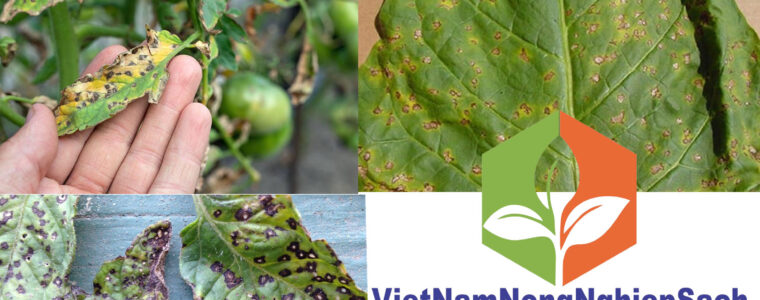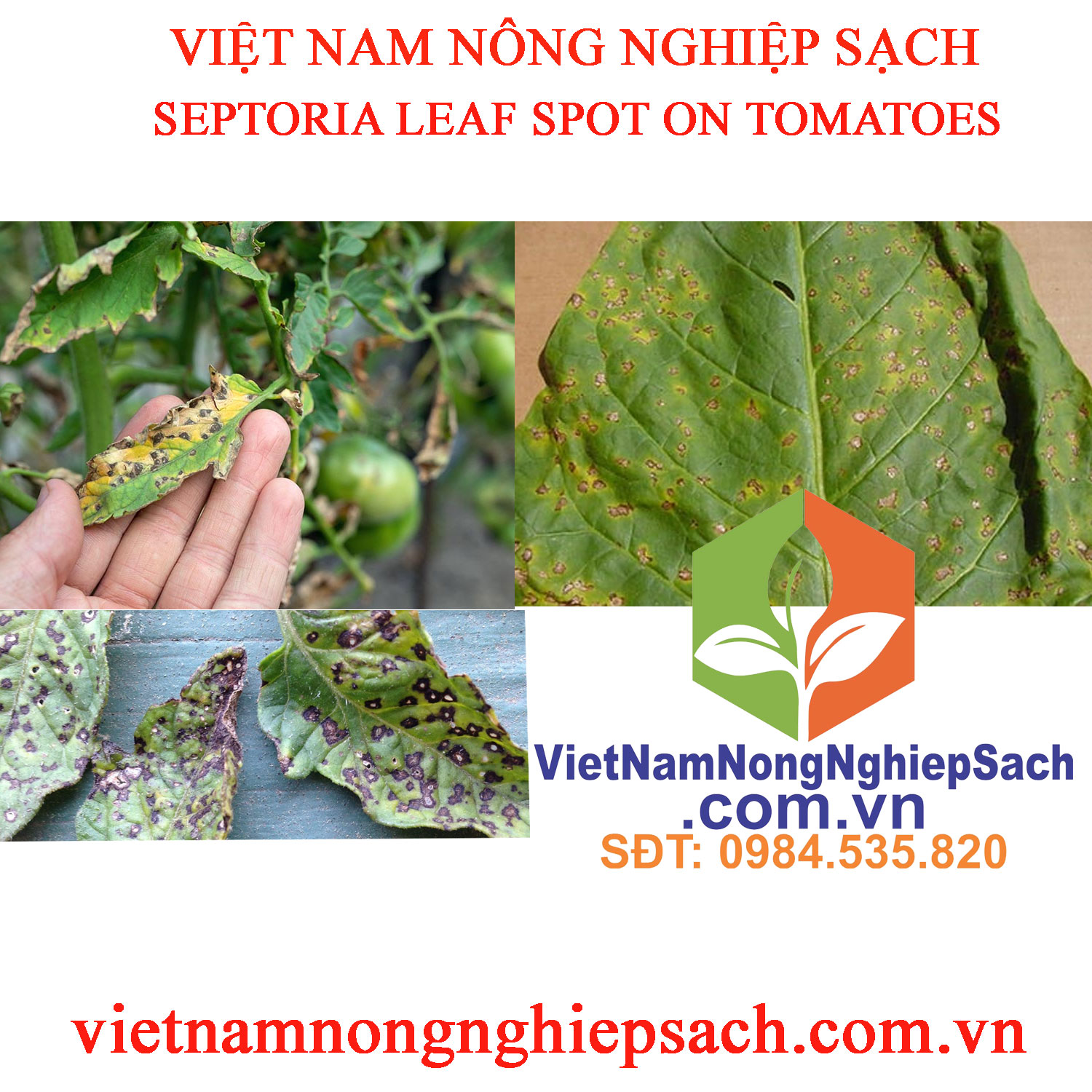
SEPTORIA LEAF SPOT ON TOMATOES VIET NAM NONG NGHIEP SACH
Septoria leaf spot is caused by a fungus, Septoria lycopersici. It is one of the most destructive diseases of tomato foliage and is particularly severe in areas where wet, humid weather persists for extended periods.

Symptoms and Diagnosis
Septoria leaf spot usually appears on the lower leaves after the first fruit sets. Spots are circular, about 1/16 to 1/4 inch in diameter with dark brown margins and tan to gray centers with small black fruiting structures. Characteristically, there are many spots per leaf. This disease spreads upwards from oldest to youngest growth. If leaf lesions are numerous, the leaves turn slightly yellow, then brown, and then wither. Fruit infection is rare.
Life Cycle
The fungus overwinters on infected tomato debris or on weeds in the nightshade family, the same family to which tomatoes belong. The fungus can also survive on equipment such as plant stakes and cages. Long periods of high relative humidity, temperatures of 60–80 degrees F, and leaf wetness are ideal conditions for development and spread of the pathogen.
Integrated Pest Management Strategies
1. Remove diseased leaves. If caught early, the lower infected leaves can be removed and burned or destroyed. However, removing leaves above where fruit has formed will weaken the plant and expose fruit to sunscald. At the end of the season, collect all foliage from infected plants and dispose of or bury. Do not compost diseased plants.
2. Improve air circulation around the plants. If the plants can still be handled without breaking them, stake or cage the plants to raise them off the ground and promote faster drying of the foliage.
3. Mulch around the base of the plants. Mulching will reduce splashing soil, which may contain fungal spores associated with debris. Apply mulch after the soil has warmed.
4. Do not use overhead watering. Overhead watering facilitates infection and spreads the disease. Use a soaker hose at the base of the plant to keep the foliage dry. Water early in the day.
5. Control weeds. Nightshade and horsenettle are frequently hosts of Septoria leaf spot and should be eradicated around the garden site.
6. Use crop rotation. Next year do not plant tomatoes back in the same location where diseased tomatoes grew. Wait 1–2 years before replanting tomatoes in these areas.
7. Use fungicidal sprays. If the above measures do not control the disease, you may want to use fungicidal sprays. Fungicides will not cure infected leaves, but they will protect new leaves from becoming infected. Apply at 7 to 10 day intervals throughout the season. Apply chlorothalonil, maneb, macozeb, or a copper-based fungicide, such as Bordeaux mixture, copper hydroxide, copper sulfate, or copper oxychloride sulfate. Follow harvest restrictions listed on the pesticide label.
Organic Strategies
Strategies 1, 2, 3, 4 and 6 are strictly organic approaches. Using an appropriate organic herbicide (or removal by hand) would be viable organic approaches to Strategy 5.
CHÚC CÁC BẠN THÀNH CÔNG
———————————————–
VIỆT NAM NÔNG NGHIỆP SẠCH
Thuốc bvtv _ hạt giống_ dụng cụ nông nghiệp
📲📲Hỗ Tư vấn kỹ thuật tại vườn📲📲
✅Liên hệ mua hàng : 0984.535.820
✅Tư vấn kỹ thuật : 0933.067.033
🏢 Địa chỉ cửa hàng : Ngã Tư khu công nghiệp Tân Phú , Khu 7 – Thị Trấn Tân Phú – Tỉnh Đồng Nai
✅Link web : https://vietnamnongnghiepsach.com.vn/
✅Link youtube 1: https://www.youtube.com/c/TrịBệnhChoCâyTrồng
✅Link youtube 2: https://www.youtube.com/c/KiếnThứcNôngNghiệp